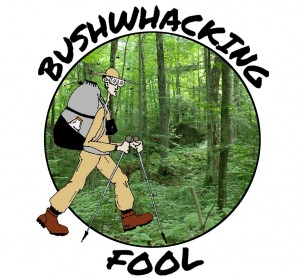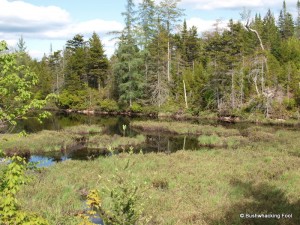
Wetland south of Ginger Ponds
After killing a couple mice at Evergreen Lake, bushwhacking to a large wetland, scampering around Peaked Mountain and Hidden Lakes, it is finally time to enter the Ginger Pond area on the very last leg of my day’s journey. Unfortunately, my chances of actually visiting the eponymous pond are fairly low, as it lies off to the north of the old logging road network, and the lateness in the day makes it unlikely I will venture outside my plan of just making camp and calling it a day.
First, I need to find a place where the climb down off the ridge and down into the Ginger Pond complex will not kill me. The descent is short, but very steep, though at this point it is pretty devoid of any understory, so the chance of being tripped up is quite low.
When I find a good spot, I serpentine my way down pretending that I am following a switch-back the whole way. Although the steep descent demands much of my attention, I cannot help myself from keeping one eye on the unnamed pond to my right. As I get close to the bottom, a male hooded merganser takes off from the pond, flying east as if I am a dangerous threat to its well-being.
Section Stats:
Date: May 31, 2014
Length: 1.5 miles (5.2 total daily miles; 12.8 total trip miles)
Difficulty: Easy
At the bottom, I work my way through a wet area before climbing slightly to another old skidder trail. Following the wet skidder trail east, I plan on trying to navigate around the pond, hoping to find the old logging road that connects Ginger Pond with the old road I took into Evergreen Lake yesterday.
As I approach a clearing, most likely a log landing from the distant past, a brown structure captures my notice. At first, it resembles a hermit hovel, but as I draw closer it is a decidedly more mundane object, a stack of firewood with a brown tarp covering it. Some of the logs look relatively recently cut, with a scattering of sawdust giving credence to this hypothesis. The extent of the wood and the sawdust give me the impression that the wood was cut illegally with a chainsaw – not a rare occasion within the Wilderness Lakes Tract from what I witnessed on this trip.
From the stack of wood there are two trails, the higher trafficked one that leads uphill to the north, while a less obvious one heads in the opposite direction through the softwoods lining the slim pond I just navigated around. With the pond still in sight, the trail down to its shore is the obvious place to start exploring. It winds through the mature softwoods for a short distance before I notice a slew of non-natural objects.
A white bucket, lashed to a tree trunk at about head level, is the first object I notice. Nearby are several large orange plastic barrels lashed together with another brown tarp covering them, apparently to act as camouflage. A long metal stovepipe lashed to a tree with bungee cords hangs from another nearby tree trunk. Between storing private property on state land and using a chainsaw, these apparent hunters seem show little appreciation for the rules and regulations governing a Wilderness Area.
Suspecting this crew is the same as the one whose campsite I found nearby during a previous trip, I am eager to find out if this is new equipment or just moved from the other location. I recall leaving a breadcrumb near their previous campsite, so maybe they decided to move it after being discovered. If so, looks like they might have to move it again this year.
With the mystery of the stacked wood successfully solved, I turn my attention to finding somewhere to camp for the night, like near this hunting group’s previous campsite. My instinct tells me that the well-used trail heading in the opposite direction might be what I am looking for, so I start climbing as it heads uphill through dense sapling growth, an another apparent leftover from past logging operations.
The trail continues to climb, with young coniferous trees guarding it on both sides. A tree-top of a small pine lies on the ground nearby. The frayed end implies that it was not cut, but torn off, though there is little evidence of teeth marks or any other clue about its origin. How did this happen?
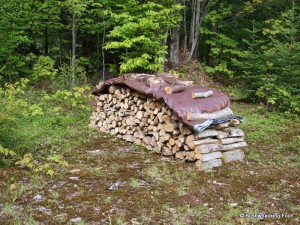
Wood pile
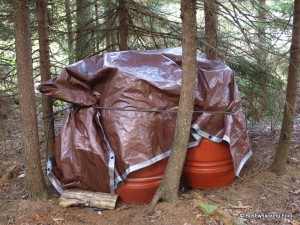
Barrels under tarp
Finally the trail levels off and ends at an intersection. The new trail is much wider and suggests a well-traveled logging road at one time. The trail west most likely returns to Slim Pond or thereabouts, which will be my exit route for tomorrow. I suspect the trail east continues through the wetlands just south of Ginger Pond, and along its path I will find a much-needed campsite for the night.
After a short distance east, the old road narrows to a foot path, before widening out to become more road-like again. Immediately, I recognize the area, as this is the location of the previous hunters’ camp, now totally abandoned. A fire ring remains, mostly sunk into the ground now, with moss and lichens covering the rocks. An old trench, apparently for routing water away from a tent, is evident in the scant sandy soil, also now full of moss and lichen, just like the rocks.
I decide to keep going down the old road for a while before deciding where to camp for the night. The trail goes between two wetlands, neither clearly visible through the surrounding trees and brush cover. The old road ascends a hill and then almost immediately descends down to a stream, complete with a large and eschew bridge. The sturdy bridge, probably constructed with logging trucks in mind, appears as if either flooding or a spring ice jam shifted it off its moorings. Fortunately, two opposing corners still make contact with each side of the stream bank – no getting wet feet here.
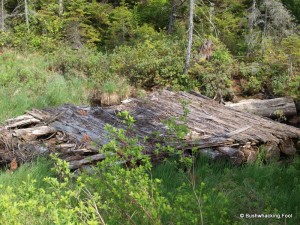
Old eschew bridge
After crossing the bridge, the trail climbs a short distance as it leaves the stream before finally leveling off. Curious as to where my wanderings are taking me, I pull out my GPS and take a look-see. Surprisingly, I find the GPS has recorded no track from soon after reaching the height of land between Hidden Lake and the unnamed pond where the wood stack is located. After some fiddling around, the GPS starts tracking again, leaving me to fix the route during post-production – blog post, that is.
Turning around, I cross the bridge again and return to the old abandoned hunters’ camp. The search for a tarp site, a food hanging tree and the like begins now. Wandering along a narrow path back into the woods, I search for a tarp site under the trees and a sturdy tree for food hanging, though all I find is an old toilet seat attached to a folding chair.
The trail quickly ends at an intersection, where I take the path to the right. Soon, I notice footprints in the trail – recent footprints. Before paranoia fully sets in, I arrive at the intersection with the trail down to the wood pile and realize the footprints are my own.
In the immortal words of Bugs Bunny, “What a maroon”. Thankfully, there is no one in my head to witness the silly mistake.
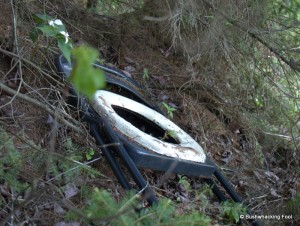
Toilet seat
I return to the old campsite where I left my pack and begin setting up my home for the evening. After preparing some water to filter, I start looking anew for a tarp location. The scant surrounding forest affords no places large enough to accommodate my tarp, so I figure the edge of the old logging road will do – it is not an official trail, so no one, but maybe a bear or some deer, should mind.
With the tarp set up at the edge of the old road, I locate a tree back along the old backdoor trail and hang my food bag. Given the approach of early evening, I quickly make my last dinner of this trip.
The black flies and mosquitoes prove to be the most intense of the trip here – perhaps camping in the middle of a wetland complex was not my best idea after all. To add insult to injury, deer flies buzz around my head incessantly, at least until the sun gets low on the horizon and it begins to cool down.
After dinner, it is still too early to call it a day, but with the horde of biting insects about my head demanding some type of movement, I set off to explore the old road again. Walking east and crossing the bridge, I return to the clearing that marks the end of the road. I theorize to myself that it probably continues straight ahead into the woods to some degree, but decide not to look for it this late in the day, it will have to wait for another day and another trip.
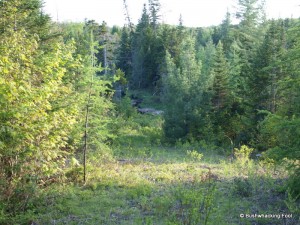
Old logging road
Returning back to camp, I take the old road back to the original intersection where I encountered it earlier in the afternoon. With more time to kill, I mosey down to the wood pile, noticing that the hooded merganser has returned to the nearby pond a short distance from the stored personal property. I feel a little backcountry guilt or disturbing him once again – but nothing compared to the incident earlier this morning.
By the time I return to my tarp, it is after eight o’clock in the evening, so I decide to hide from the early evening scramble of biting insects and crawl underneath to my mosquito-proof shelter. It has been a long day and the noisy birds will have me up early tomorrow morning, providing me with a jumpstart to my trip back to civilization tomorrow morning.
As I drift off to sleep, thoughts of ghost logging equipment coming down the road intrude upon mind, despite the serenity of my surroundings. I draw comfort from the fact that any traveler is more likely to be a living deer, bear, coyote or other wild animal than some ethereal apparition.
Whatever shows up, I hope I am not mistaken for a small pine tree. I would hate to wake up with my head torn off.
Affiliate Disclaimer: Some links within this blog post may send you to a retailer’s website. If you chose to purchase any product on that site, this author may receive a small commission at no extra cost you. These commissions provide compensation for the author’s time and effort necessary to provide the content at the Bushwhacking Fool.
